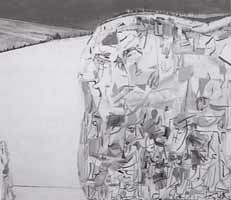For ‘Flash Art’ magazine
Against all odds, a tiny figure pulls an enormous bundle filled with a jumble of surreal forms by a slender rope across the white expanse of a snowy mountainside. This literalization of ‘personal baggage’ was the subject of ‘Me and Ugly Mountain,’ the first painting to greet visitors to Amy Sillman’s sixth New York solo show. As suspiciously humorous as the diminutive soldier who famously encouraged his buddies to “…pack up their troubles in their old kit-bags and smile, smile, smile,” the opening painting provoked a grin, but it was one that could quickly turn quizzical. ‘Me and Ugly Mountain’ juxtaposed oddball characters with semi-abstract, expressionist compositions, creating a unique mix of levity and gravity.
Titled, ‘I am curious (yellow),’ the exhibition’s bright colors and quirky, cartoony figures suggested a lightness that was wasn’t upheld by the subject matter. Dramatically divided landscapes dominated in pieces like ‘Hamlet,’ which presented a cross-section of earth, with flattened human bodies representing layers of subsoil. Shooting from the earth like a jet of water, a long-necked, balloon-like head shouted ‘hello.’ Likewise, in the apocalyptic ‘Unearth,’ brilliant red and orange streams of light in the heavenly realms are separated from the drab earth below save for a mountain, straining to meet a little blue cord dangling from above. In the back gallery, a colorful patchwork of twenty-five paintings on paper shifted the focus onto abstract shapes and drawn figures, like the irritated beauty whose body was stretched like a trampoline supporting several pairs of feet.
In her work on paper, Sillman tempted viewers to decode her private symbolic language. The paintings, on the other hand, defied verbal description. Their roiling compositions and vibrant colors were a visual experience, unraveled through determined looking. But in ‘Letters from Texas,’ the third major component of the exhibition, Sillman abandoned her de Kooningesque tangles of line and the energy dissipated. This end-to-end installation of paintings flipped the focus onto the cartoony figures, losing the drama of the large canvases and suffering from a lack of continuity. Nevertheless, the main body of painting combined the fantastical and the funny, abstract and figurative, in a way that rewarded viewers who took the time to enter into Sillman’s zany universe.